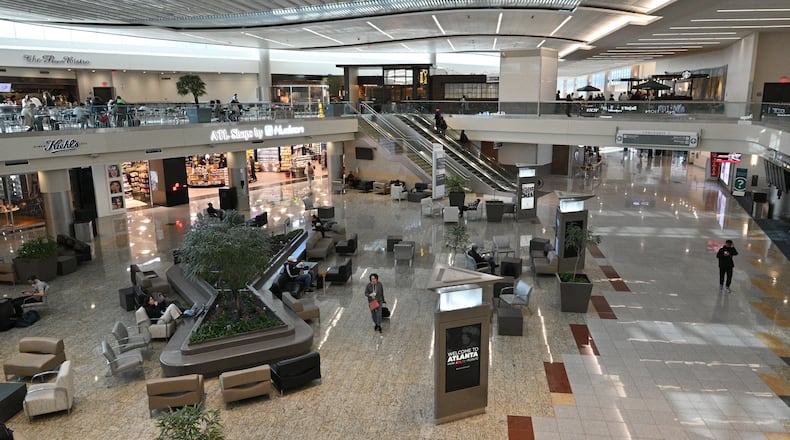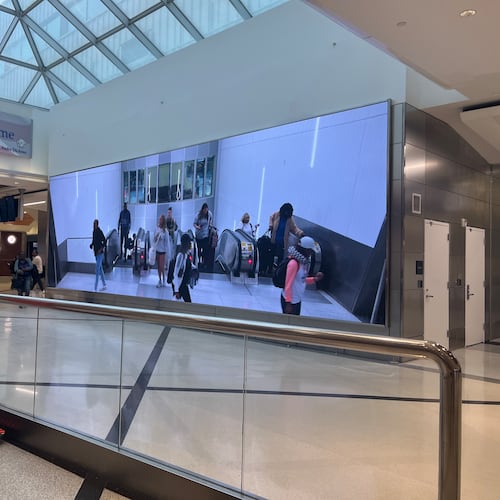The most dazzling part of the world’s busiest airport has soaring ceilings and an enormous Swarovski crystal chandelier — but is seen by only a small fraction of travelers passing through Hartsfield-Jackson International.
That’s partly because the Maynard H. Jackson Jr. International Terminal, turning 10 years old this week, has not met the passenger loads for which it was built.
It roars to life during peak periods, in the mornings and late afternoons, when large long-haul jets roll up to its gates to offload and reload hundreds of passengers.
After a decade of hosting travelers from around the world, though, it is still mostly empty during much of the day and night.
The international terminal’s sleek lines and empty corridors stand in stark contrast to the crammed, crowded and less-luxurious domestic concourses.
Hartsfield-Jackson’s international gateway faces an even steeper uphill climb to fulfill its potential after the pandemic pummeled foreign travel. International passengers made up fewer than 12% of total travelers at Atlanta’s airport before the pandemic, and last year were less than half of pre-pandemic levels.
Credit: Hyosub Shin
Credit: Hyosub Shin
When the $1.4 billion complex opened to the world on May 16, 2012, it introduced a “second front door” to the airport with a new terminal for check-in, security and baggage claim and a 12-gate Concourse F.
With it came not only a showcase design that set it apart from the rest of the airport, but an additional customs facility, parking and a new set of roadways to the terminal off I-75, on the east side of the airport.
The terminal’s designers wanted to “make it seem like it was a flowing space,” said Wilson Rayfield, who was on the architectural team for the project and is executive vice president at design firm Gresham Smith.
A trademark is its walls of windows offering expansive views of aircraft on the tarmac and beyond.
“It’s one of the few terminals at any airport where you can walk into the ticket lobby and immediately see outside... and have an immediate connection to where the airplanes are,” Rayfield said.
Credit: Steve Schaefer
Credit: Steve Schaefer
Hartsfield-Jackson General Manager Balram Bheodari said the terminal was created to welcome international travelers to Atlanta and ensure capacity for increased international passenger volume. “We accomplished both goals,” he said.
Here’s the story behind the international terminal, what travelers experience and prospects for recovery.
International traffic
When a new terminal was first envisioned in the late 1990s, airport planners thought there could be 121 million total passengers through the Atlanta airport by 2015.
By the time the terminal opened in 2012, the estimates for overall traffic were more modest, and Hartsfield-Jackson officials expected 13 million international passengers by 2015.
Economic volatility and high fuel costs have kept international traffic from reaching those levels. Atlanta came close in 2019, with 12.7 million international passengers out of 110.5 million total at Hartsfield-Jackson.
International gates are often used for domestic flights for much of the day.
International travel took a sharp dive when the pandemic hit. Only 5.7 million international passengers passed through the Atlanta airport last year, and recovery could take years.
Credit: Curtis Compton
Credit: Curtis Compton
“Atlanta finishes this nice big, grand new international terminal, and then the bottom falls out,” said Chuck Stipancic, an investor in airports and airport infrastructure based in Virginia. But, “we’ve got to look to the long term, because what happens now or next year is not going to dictate what happens 10 years from now.”
Other international hubs face similar challenges, he said.
“I think traffic will pick up,” he said. “Years later you look back in the rearview mirror and say, yeah, it’s recovered.”
Credit: HYOSUB SHIN / AJC
Credit: HYOSUB SHIN / AJC
Connectivity
Two weeks before opening day in 2012, the airport held a dress rehearsal with more than 1,600 “mock travelers“ testing the new facility.
Soon, airport officials got a taste of some of the complaints that have dogged the terminal ever since. The lack of Plane Train connectivity for some passengers to other parts of the airport. Long walks. Shuttle waits.
One of the biggest is challenging connectivity to the airport’s MARTA station.
Credit: ArLuther Lee
Credit: ArLuther Lee
The international terminal helps to alleviate congestion on the main terminal’s roadways, parking lots and security checkpoints by spreading traffic to another part of the airport. When security lines are particularly long at domestic, the international terminal is sometimes used as an alternate gateway.
But travelers arriving at the international terminal must take a shuttle bus to get to MARTA and long waits can sometimes frustrate weary passengers.
“It is very inconvenient if you in fact are coming in on the international side and have to come back over to domestic,” acknowledged Jai Ferrell, Hartsfield-Jackson’s chief commercial officer.
City Councilwoman Mary Norwood recently asked why connectivity can’t be improved. “I’ve been asking the question for years,” she said last month.
Officials have said there is potential for bus rapid transit.
“Can a monorail or something like that be built? Yes. But it’s not going to be cost effective,” said Tom Nissalke, the airport’s assistant general manager of planning and development.
Another frustration is that some international travelers face walks of up to six-tenths of a mile after landing to get to U.S. Customs and Border Protection screening. The airport in 2014 added electric carts to transport some passengers along the lengthy path.
Credit: Steve Schaefer
Credit: Steve Schaefer
Concessions
Ten years in, the full slate of shops and restaurants at the international terminal hasn’t appeared. The terminal opened with the feel of a luxury mall, but retailers like Coach, Michael Kors and Mont Blanc closed after struggling for years with lackluster demand.
Spa and sleep unit locations have yet to open.
It wasn’t just the pandemic. Luxury retailers in airports have had to compete with the rise of online retail.
Future plans could depend on staffing and “appetite for using those kinds of services in the post-COVID space,” said Ferrell, the airport’s chief commercial officer. “I wouldn’t be shocked if people start to reimagine” plans, she said.
Some concessions haven’t yet reopened since the pandemic started, including a Jekyll Island Seafood Co. restaurant.
Other parts of the terminal have changed or disappeared.
A suspended sculpture in the international food court atrium, “airFIELD” by California artist collective Uebersee, had two intersecting, swooping shapes resembling a bird in flight. They were comprised of round acrylic discs programmed to turn opaque in movements that replicate flight paths using actual data from FlightAware.
But the system that sent electric charges to display the flight paths on the discs was eventually turned off, and now the sculpture has been removed entirely.
Credit: HYOSUB SHIN / AJC
Credit: HYOSUB SHIN / AJC
The making of the international terminal
From its inception, the international terminal brought scrutiny of its price tag, its name and the airport contracting process.
2000: Planning begins for an international terminal with separate access off I-75.
2003: The international terminal’s name is settled following the death of Maynard Jackson, the first black mayor of Atlanta. Jackson supporters wanted the airport renamed in his honor, but faced pushback from those who didn’t want the name of former Mayor William B. Hartsfield removed. A racially charged debate led to a compromise to name the new international terminal after Jackson and add Jackson’s name to the airport.
2005-2006: Costs climbed from $688 million to $828 million and airport officials said a planned opening in 2006 would be delayed to 2009. The airport also fired its original designer, saying the plans were over-budget and too “luxurious.” But that firing drove costs further to more than $1 billion. Eventually, costs would rise to $1.5 billion after a new design firm, Gateway Designers, was selected.
2009: The terminal’s price tag soared again to $1.7 billion and sparked a dispute between the airport’s then-manager, Ben DeCosta, and Richard Anderson, who was Delta Air Lines’ chief executive at the time. Amid lease negotiations, Delta insisted the cost must come down and threatened to move some of its flights to other hubs away from Atlanta. DeCosta eventually agreed to cut costs and the project moved forward.
2012: Contracts for new restaurants and shops throughout the airport sparked protests and appeals from businesses that weren’t picked, threatening to delay the new terminal’s opening.
Some of the largest restaurants, including Ecco, Jekyll Island Seafood Company and Lorena Garcia Tapas Bar, were not completed until months after the terminal opened. Contracting problems delayed the opening of The Club ATL airport lounge.
Others went through a whirlwind of challenges and barely made it for opening day in May 2012.
Credit: HYOSUB SHIN / AJC
Credit: HYOSUB SHIN / AJC
About the Author
The Latest
Featured












